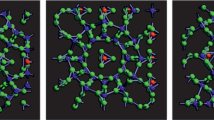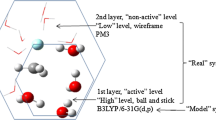Abstract
It is shown that the CH acidity of di- and trisubstituted methanes can be studied using the ap- proaches consisting in singling out the contributions of physically significant factors from the overall acidification mechanisms in the gas phase and in solution. This procedure implies formal decomposition of the calculated gas-phase deprotonation energy ΔEdeprot into the following terms: electrostatic energy of proton detachment from the “acid” CH bond, with the state of the remainder of the molecule absolutely unperturbed (ΔE 1); electronic relaxation energy of the resulting molecular residue and formation of a “virtual” carbanion therefrom (ΔE 2); the ΔEdeprot component due to displacement of the atomic nuclei on changing from the “virtual” to real carbanion ΔE 3. Relationships between the energy components ΔE 1, ΔE 2, ΔE 3, and the commonly used characteristics of the molecular structure were investigated. The parameter ΔE 1 is selectively sensitive to the inductive effect of the substituent. Imperfect correlation between ΔE 1 and the sum of the σI constants can be due to the fact that the contributions to the σI constants from the effective charge on the hydrogen atom of the CH bond being deprotonated and from the polarizabilities of the substituents are not taken into account. In contrast to monosubstituted methanes, in di- and trisubstituted methanes there is no correlation between the ΔE 2 component and the 1 J(13CH) constants. The linear dependence linking the sums of the components ΔE 1 + ΔE 2 and the pyramidal angle in the carbanions is responsible for the relaxation nature of the effects associated with the ΔE 2 + ΔE 3 sum. Comparison of the data obtained with the calculated patterns of redistribution of the effective charges on atoms accompanying conversion of CH acids to carbanions enabled elucidation of the relative contribution of each of the components, ΔE 2 and ΔE 3, to the deprotonation energy of selected groups of substituted methanes. The previously developed technique of separating the energy of protolytic equilibrium in the gas from that of solvation processes in solution enabled assessment of the contributions from electrostatic solvation to pK a in DMSO. The same technique of singling out the solvation component due to intermolecular hydrogen bonds from pK a(H2O) was used in studying the acid-base equilibria for substituted methanes in aqueous solution. It was shown that the solvation effects manifested in the liquid-phase CH acidity can be modeled by the effects revealed for analogous hydrogen bonds of ion-molecule complexes in the gas phase. The relationships between the strength of hydrogen bonds and the CH-acidic properties of compounds in the gas phase and liquid water are similar.
Similar content being viewed by others
REFERENCES
Tupitsyn, I.F., Popov, A.S, and Zatsepina, N.N., Zh. Obshch. Khim., 1998, vol. 68, no. 8, pp. 1376-1382.
Tupitsyn, I.F., Zatsepina, N.N., and Kaufman, V.Z., Zh. Obshch. Khim., 1995, vol. 65, no. 9, pp. 1500-1516.
Tupitsyn, I.F., Popov, A.S., and Zatsepina, N.N., Zh. Obshch. Khim., 1998, vol. 68, no. 3, pp. 449-460.
Tupitsyn, I.F., Popov, A.S., and Zatsepina, N.N., Zh. Obshch. Khim., 1996, vol. 66, no. 8, pp. 1308-1320.
Koppel, J.A., Taft, R.W., Anvia, F., DesMarter, D.D., Yagupolskii, L.M., Ignatev, N.V., Vlasov, V.M., and Notario, R., J. Am. Chem. Soc., 1994, vol. 116, no. 7, pp. 3047-3057.
Castejon, H.J. and Wiberg, K.B., J. Org. Chem., 1998, vol. 63, no. 12, pp. 3937-3742.
Ionin, B.I. and Ershov, B.A., YaMR spektroskopiya v organicheskoi khimii (NMR Spectroscopy in Organic Chemistry), Leningrad: Khimiya, 1967.
Maciel, G.E., McIver, I.W., Ostlund, N.S., and Pople, I., J. Am. Chem. Soc., 1970, vol. 92, no. 1, pp. 1-11.
Juan, C. and Gutowsky, R., J. Chem. Phys., 1962, vol. 37, no. 10, pp. 219-228.
Hirshfeld, F.J., Theor. Chim. Acta, 1977, vol. 44, no. 2, pp. 122-138.
Taft, R.W., Abboud, I.T., and Anvia, F., J. Am. Chem. Soc., 1988, vol. 110, no. 6, pp. 1797-1800.
Afonin, A.V., Viznani, S., Ruie de Azua, M., and Kontreras, R.H., Izv. Ross. Akad. Nauk, Ser. Khim., 1996, no. 6, pp. 1362-1365.
Bent, H., Chem. Rev., 1961, vol. 61, no. 3, pp. 275-311.
Reutov, O.A., Beletskaya, I.P., and Butin, K.P., CH-Kisloty (CH Acids), Moscow: Nauka, 1980, p. 63.
Kitchie, C., Solute-Solvent Interactions, Goetze, M., Ritchie, C.D., and Decker, A., Eds., New York: Pergamon, 1976, p. 219.
Kolthoff, J.M., Anal. Chem., 1974, vol. 46, no. 8, pp. 1992-1996.
Aue, D.H., Webb, H.M., and Bowers, M.T., J. Am. Chem. Soc., 1976, vol. 98, no. 2, pp. 318-329.
Tupitsyn, I.F., Popov, A.S., and Shibaev, A.Yu., Zh. Obshch. Khim., 1992, vol. 62, no. 9, pp. 2100-2111.
Tupitsyn, I.F., Popov, A.S., Zatsepina, N.N., and Kaufman, V.Z., Zh. Obshch. Khim., 1998, vol. 68, no. 7, pp. 1128-1137.
Tupitsyn, I.F. and Popov, A.S., Zh. Obshch. Khim., 1995, vol. 65, no. 3, pp. 446-457.
Tupitsyn, I.F. and Popov, A.S., Zh. Obschch. Khim., 1994, vol. 64, no. 5, pp. 783-795.
Bordwell, F.G., Acc. Chem. Res., 1988, vol. 21, no. 12, pp. 456-463.
Streitwieser, A.I., Jurasti, E., and Nebezahl, L.L., Comprehensive Carbanion Chemistry, New York: Elsevier, 1980, pp. 334-384.
Wiberg, K.B., Castejon, H., and Keith, T.A., J. Comput. Chem., 1996, vol. 17, no. 2, pp. 185-190.
Symons, E.A. and Clermont, M.I., J. Am. Chem. Soc., 1981, vol. 103, no. 11, pp. 3127-3130.
Ivanov, A.I., Slovetskii, V.I., Shevelev, S.A., Fainzil'berg, A.A., and Novikov, S.S., Zh. Fiz. Khim., 1966, vol. 40, no. 9, pp. 2298-2301.
Koppel, J.A., Melder, U.H., and Palm, V.A., Reakts. Sposobn. Org. Soedin., 1985, vol. 22, no. 1, pp. 43-47.
Belikov, V.M. and Belokon', Yu.N., Izv. Akad. Nauk SSSR, Ser. Khim., 1971, no. 2, pp. 335-342.
Speers, P., Laidig, K.E., and Streitwieser, A.J., J. Am. Chem. Soc., 1994, vol. 116, no. 20, pp. 9257-9261.
Wiberg, K.B. and Castejon, H., J. Org. Chem., 1995, vol. 60, no. 20, pp. 6327-6334.
Guthrie, I.P., Chem. Biol., 1996, vol. 3, no. 2, pp. 163-170.
Gerit, I.A., Kreevoy, M.M., and Cleland, W.W., Chem. Biol., 1997, vol. 4, no. 4, pp. 259-267.
Abbato, A., Breadmante, S., and Pagani, A., J. Org. Chem., 1993, vol. 50, no. 2, pp. 449-455.
Meot-Ner, M., J. Am. Chem. Soc., 1984, vol. 106, no. 17, pp. 1257-1265.
Meot-Ner, M., J. Am. Chem. Soc., 1988, vol. 110, no. 12, pp. 3858-3862.
Gatev, G.G., Zhong, M., and Brauman, J.I., J. Am. Chem. Soc., 1998, vol. 120, no. 42, pp. 10863-10870.
Author information
Authors and Affiliations
Rights and permissions
About this article
Cite this article
Tupitsyn, I.F., Popov, A.S. CH Acidity of Di- and Trisubstituted Methanes. Russian Journal of General Chemistry 71, 89–101 (2001). https://doi.org/10.1023/A:1012341708989
Issue Date:
DOI: https://doi.org/10.1023/A:1012341708989




